1950s
Miss Vice
In 1950, while Americans were bestowing titles such as 'Miss Potato Chip' or 'Miss Typical Teen' on young women, the French elected a 'Miss Vice'.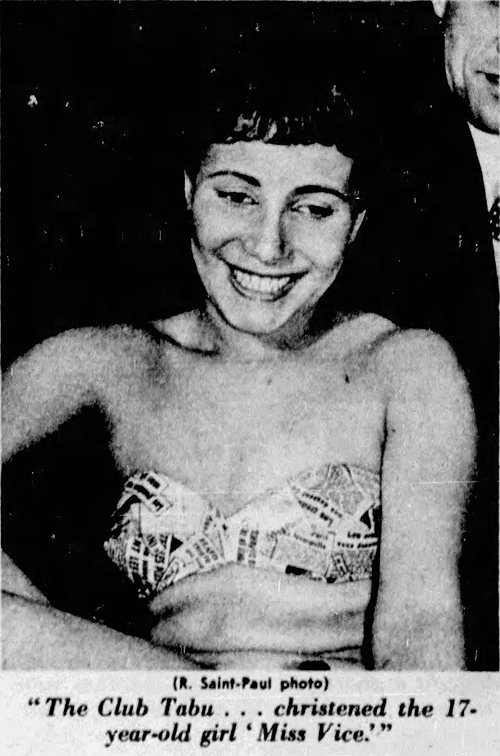
Chicago Tribune - July 3, 1950
The winner was 17-year-old Diane Erdos. Some details from the NY Daily News (Jun 25, 1950):
The sexy brunette showed up with a costume made of three rather small pieces of newspaper — and won hands down over eight other contestants. The selection was popular. The crowd in the smoke-filled Cave Tabou congratulated Diane so enthusiastically that she lost her clippings and was carried unadorned on the shoulders of her admirers until the cops rescued her with a voluminous cape.
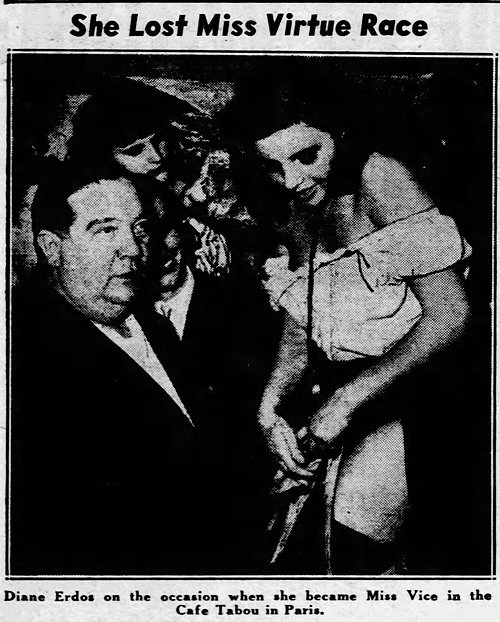
NY Daily News - June 25, 1950
Miss Vice, who was the daughter of a wealthy industrialist, was soon after arrested for trying to blackmail one of her father's friends, threatening to tell the police that he was trafficking cocaine and illegally exporting ball bearings to countries behind the Iron Curtain.
When arrested, she confessed, saying, "I wanted the money to travel around the country and teach Existentialism to the youth of France. I intended to reveal my body in the interests of this new religion, so the sensation would bring me big audiences of young people to hear about M. Sartre's new philosophy."
Posted By: Alex - Wed Sep 01, 2021 -
Comments (2)
Category: Awards, Prizes, Competitions and Contests, Philosophy, Ethics and Morals, 1950s
Channel Surfing in the 1950s
How did people channel surf in the 1950s, before the invention of remote controls?Mrs. Cooper's solution was to own a different TV set for every channel. To change channels she just had to move to a different room.

Medford Mail Tribune - Mar 28, 1957
Posted By: Alex - Sun Aug 29, 2021 -
Comments (4)
Category: Television, 1950s
Unlikely Reasons for Murder No. 5
Suicide is self-murder, and offing oneself because your murderous insurance scam has come unraveled seems a bit more unlikely than accepting the punishment. Extra points given for swallowing poison in front of the cops. How did he have it so handy?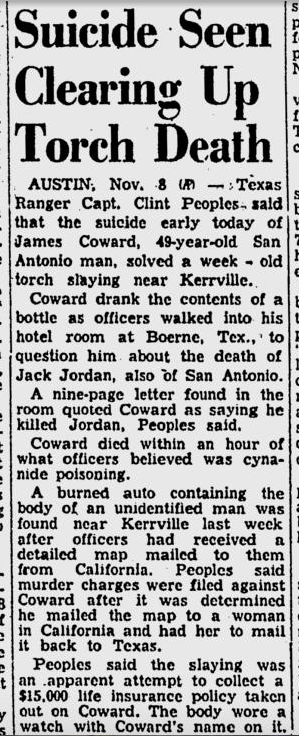
Source: The Daily Journal (Commerce, Texas) 09 Nov 1956, Fri Page 1
Posted By: Paul - Thu Aug 19, 2021 -
Comments (5)
Category: Death, Suicide, Scams, Cons, Rip-offs, and General Larceny, Stupid Criminals, 1950s
Soundblast
Soundblast was a 1956 album by the duo Arthur Ferrante and Louis Teicher who met while studying at the Juilliard School of Music. It was marketed as space-age music representative of the kind of music that inhabitants of the "remotest worlds" might listen to.But the real gimmick of the album was that all the sounds on it, including the percussion, was produced by pianos. Details from the Miami News (Nov 17, 1957):
Nor does either of them hesitate to use his elbow, forearms or knuckles to elicit a desired chordal effect—not to mention an assortment of wooden and metal gadgets designed to give the pianos a new personality...
Their goal always is to achieve the maximum tonal contrasts and to simulate orchestral color as vividly as possible within the limitations of pianistic dynamics.
More info: The Soundblast liner notes
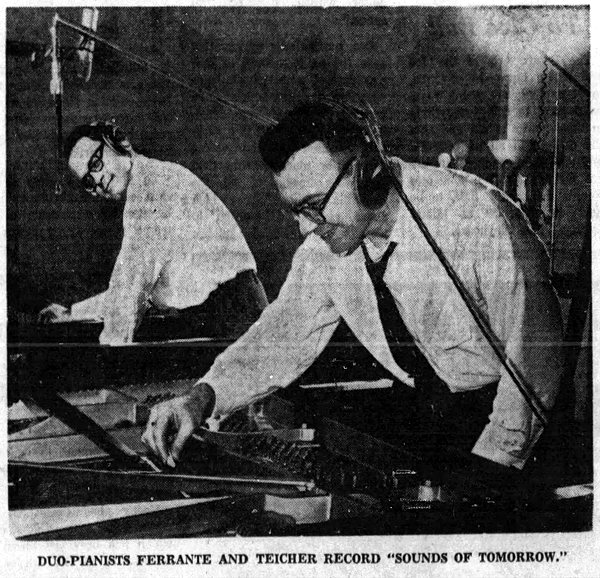
Miami News - Nov 17, 1957
Wikipedia has an interesting biographical detail about Ferrante. Apparently he died in 2009, twelve days after his 88th birthday, thereby fulfilling his ambition to live one year for each piano key.
Posted By: Alex - Thu Aug 12, 2021 -
Comments (1)
Category: Music, Space-age Bachelor Pad & Exotic, 1950s
By the Light of the Silvery Moon
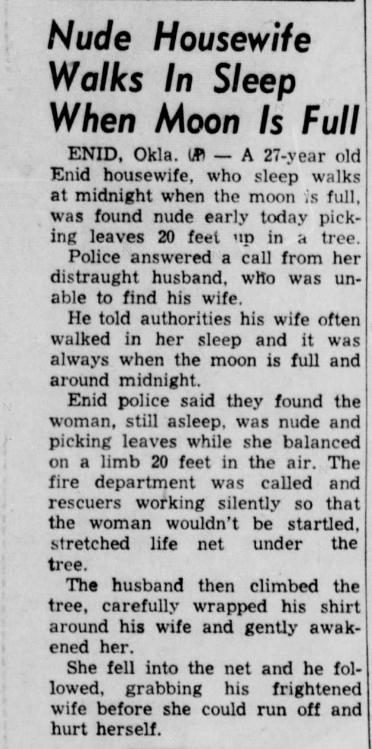
Source: The Escanaba Daily Press (Escanaba, Michigan) 30 Jun 1953, Tue Page 8
Posted By: Paul - Wed Aug 11, 2021 -
Comments (0)
Category: Public Humiliation, Sleep and Dreams, Public Indecency, 1950s
Miss Mayonnaise and Miss Salad Dressing
June 1952: Joan Corbett was named 'Miss Mayonnaise' while her twin sister, Jean, was given the title of 'Miss Salad Dressing'.
Los Angeles Times - June 11, 1952

Pasadena Independent Sun - June 8, 1952
Here's a better picture of the twins.

And here they are in a 1954 ad for Chesterfield Cigarettes.

The Burbank High School 'In Memoriam' blog has some biographical info about them:
Posted By: Alex - Sat Aug 07, 2021 -
Comments (4)
Category: Awards, Prizes, Competitions and Contests, Mayonnaise, 1950s
The Power of Prayer on Plants
According to the Rev. Franklin Loehr, prayer could supercharge the growth of plants. Pretty much any prayer would work. He detailed his argument in his 1959 book The Power of Prayer on Plants.When Richard Nixon was told of Loehr's results, he reportedly said, "That sounds like a good kind of thinking to me."
However, in 1961, a group of Harvard students tried to replicate Loehr's results and failed to do so. In fact, in their experiment the plants that weren't prayed for at all grew better than plants that were prayed for by either skeptics or believers.

More details from Newsweek (Apr 13, 1959):
Can prayer make plants grow faster and bigger? Skeptics think it laughable, scientists find it irrelevant, and farmers tend to rely on more mundane methods to increase their crops. But the Rev. Franklin Loehr is convinced that the answer is yes, and has just written a book, "The Power of Prayer on Plants," to tell why.
After five years and 900 experiments, the 46-year-old Presbyterian minister reports he and 150 members of his prayer group found that prayed-for wheat and corn seeds grew into bigger seedlings than ones which got no prayer or outright negative prayer. Commenting on their methods last week in his Los Angeles home, Mr. Loehr explained that they used every kin of prayer and found every one effective to a degree.
"There were silent and spoken prayers," he continued, "those to loved ones, and the humble prayer straight to God. But mostly people just talked to the plants, loved them, or scolded them. First I tried buddying up to them, and then I observed that the people getting better results were approaching the plants on their own level of consciousness."
Picking up a copy of the book, he pointed to the jacket, which shows a lone, stunted shoot on the no-prayer side of an experimental seedbed. "He wasn't supposed to be there," explained Mr. Loehr, "so we blighted him with three bursts of negative command."
Mr. Loehr dropped the experiments two years ago, having persuaded himself, at least, of their validity. He is now concentrating on "soul dynamics" prayer for people—not, of course, to make them grow faster and bigger. "The fact is," he concluded, "we used plants to test prayer just as the artificial heart is tested in dogs instead of humans."

Along similar lines, see our previous post "Does holy water help radishes grow better?"
Posted By: Alex - Fri Aug 06, 2021 -
Comments (2)
Category: Religion, Experiments, Books, 1950s
The Seattle Seafair Queen
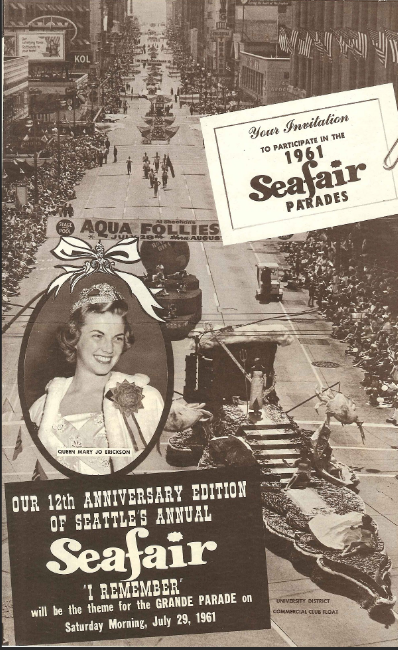

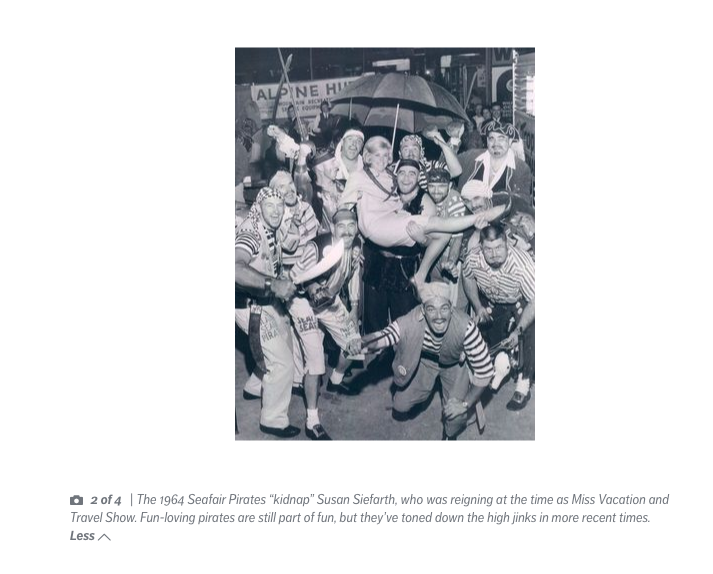
It's too bad that the raucous early years, with roving pirates, did not last into our era.
Article here.
More pictures of queens here.
Posted By: Paul - Mon Aug 02, 2021 -
Comments (0)
Category: Awards, Prizes, Competitions and Contests, Beauty, Ugliness and Other Aesthetic Issues, Parades and Festivals, Regionalism, 1950s
So easy a four-year-old can do it
From Newsweek - Jan 2, 1950:Pamela doesn't look like she's having fun.

Posted By: Alex - Fri Jul 30, 2021 -
Comments (6)
Category: Publicity Stunts, Children, 1950s
The Mystery Girl from the World of Autodynamics
In late 1956, a celebrity in disguise as the "Mystery Girl from the World of Autodynamics" toured car shows and dealerships. The public was challenged to guess her identity to have a chance to win a new 1957 Dodge.Can you guess who she was? The answer is below in extended.
Here's a hint. She's not an A-list celebrity, but we've posted about her before on WU.


North Hollywood Valley Times - Nov 24, 1956
More in extended >>
Posted By: Alex - Wed Jul 28, 2021 -
Comments (4)
Category: Publicity Stunts, 1950s, Cars

| Who We Are |
|---|
| Alex Boese Alex is the creator and curator of the Museum of Hoaxes. He's also the author of various weird, non-fiction, science-themed books such as Elephants on Acid and Psychedelic Apes. Paul Di Filippo Paul has been paid to put weird ideas into fictional form for over thirty years, in his career as a noted science fiction writer. He has recently begun blogging on many curious topics with three fellow writers at The Inferior 4+1. Contact Us |




